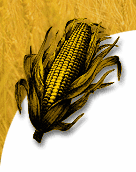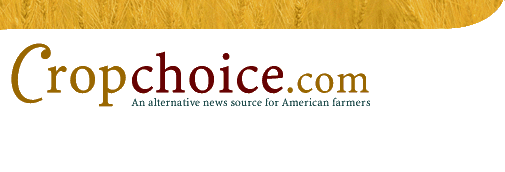By Gene Logsdon
The Prairie Writers Circle
(Friday, Sept. 13, 2002 -- CropChoice guest commentary) -- When farmers started telling me that they were getting rid of their
machinery and putting their entire farms into pasture, I thought, "Yeah,
right."
But when they led me around their farms more or less by the nose to prove
it, I became a believer. After five years of experimentation, I, like
thousands of farmers now, know that meat, milk, eggs and other farm products
can be raised without annually cultivated crops, sometimes even without
barns. In most American climates, grazing animals need only a wood lot or
windbreak for shelter, will harvest grass and legumes themselves for their
feed, and will control most weeds and spread their manure for fertilizer for
free.
At the Bruce and Lisa Rickard farm near Mount Vernon, Ohio, there are about
25 beef cows and calves, 600 head of sheep and not a stalk of corn or
soybeans. The only barn is a shearing shed. "Eventually," Bruce said, "we
think we can perfect rotational grazing to the point where we can graze
year-round and get rid of the haying machinery, too."
"You can dynamite all those stupid silos, too," added Bob Evans, a lifelong
cattleman near Gallipolis, Ohio. With improved plants, he has proved that he
can raise beef on pasture year-round.
It takes only a cursory comparison of today's industrial grain farming with
pastoral farming to show how the latter's day has come again.
In a typical industrial operation, farmers go to the fields in spring with
enormously expensive machines used hardly 30 days of the year and prepare a
seedbed, and/or spray it with herbicides. Then they frantically sow
expensive bioengineered seed between showers with huge, expensive planters
and apply expensive fertilizers that are made with fossil fuel or hauled
from mines up to thousands of miles away. To cover themselves from bad
weather, they buy expensive insurance.
At harvest time, into the fields they go again with enormously expensive
combines, praying for good weather, not mud that will harmfully compact
under the dinosaur-size machines. The grain goes into expensive trucks and
is hauled to expensive elevators or expensive on-farm storage, where it must
be binned, dried with fossil fuel, then watched for insect infestation.
Then the grain must be loaded and moved again, by rail or truck or barge, at
a great consumption of fuel and infrastructure, to expensive animal
factories where it is ground into meal in expensive mills and fed to animals
that are kept healthy in their crowded quarters by costly - in more ways
than one - hormones and antibiotics.
The manure, sometimes in quantities as great as the sewage of large cities,
is stored using enormous amounts of water. At great expense it is finally
hauled out and applied on soil or gotten rid of some other way. The Dutch
have shipped it to Saudi Arabia. All of this brings constant protests and
nuisance suits of neighbors angry about the odors and flies.
Then much of the meat, milk and eggs must be shipped back to where the grain
came from. Surely, lunacy has come to agriculture.
Compare that with the husbandry of pasture farming. Once the pastures are
established, the only field work is moving the animals between grazing
paddocks and keeping the fences repaired. If rains pour in spring, summer or
fall, the farmer rejoices over better grass. After a summer drought, the
grasses and legumes bounce back with a little rain, while the corn and
soybeans are finished.
But the real impetus pushing pasture farming is a consumer revolution.
Scores of scientific and journalistic reports, such as Jo Robinson's popular
little book, "Why Grassfed Is Best!," demonstrate that meat, milk and eggs
produced on pasture are more healthful. Some of the advantages over heavy
grain feeding are less fat, more beneficial Omega-3 fatty acid and
conjugated linoleic acid, and a lower risk of E. coli.
Why aren't all farmers opting for pasture? It takes a long time to change a
culture, and America, in terms of the protein we eat, is a corn-belt
culture. About 85 percent of our corn goes to farm animals. The market
rewards this with higher prices but does not offer any incentive or premium
for things like linoleic acid content. Our culture also believes that grain
fed meat tastes better, which many others and I now know is myth. The beef
and lamb we have raised on good pasture and mother's milk is just as tasty
as any corn-fattened steak or lamb chop in Omaha.
- Gene Logsdon, who farms near Upper Sandusky, Ohio, is a member of The
Prairie Writers Circle, a project of The Land Institute, a Natural System
Agriculture research organization in Salina, Kan. He is the author of many
books including one scheduled to come out next year on pasture farming.



